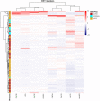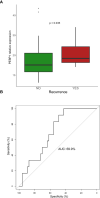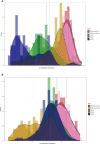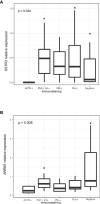Molecular characterization of epithelial-mesenchymal transition and medical treatment related-genes in non-functioning pituitary neuroendocrine tumors
- PMID: 37033229
- PMCID: PMC10074986
- DOI: 10.3389/fendo.2023.1129213
Molecular characterization of epithelial-mesenchymal transition and medical treatment related-genes in non-functioning pituitary neuroendocrine tumors
Abstract
Introduction: Different medical therapies have been developed for pituitary adenomas. However, Non-Functioning Pituitary Neuroendocrine Tumors (NF-PitNET) have shown little response to them. Furthermore, epithelial-mesenchymal transition (EMT) has been linked to resistance to medical treatment in a significant number of tumors, including pituitary adenomas.
Methods: We aimed to evaluate the expression of EMT-related markers in 72 NF-PitNET and 16 non-tumoral pituitaries. To further explore the potential usefulness of medical treatment for NF-PitNET we assessed the expression of somatostatin receptors and dopamine-associated genes.
Results: We found that SNAI1, SNAI2, Vimentin, KLK10, PEBP1, Ki-67 and SSTR2 were associated with invasive NF-PitNET. Furthermore, we found that the EMT phenomenon was more common in NF-PitNET than in GH-secreting pituitary tumors. Interestingly, PEBP1 was overexpressed in recurrent NF-PitNET, and could predict growth recurrence with 100% sensitivity but only 43% specificity. In parallel with previously reported studies, SSTR3 is highly expressed in our NF-PitNET cohort. However, SSTR3 expression is highly heterogeneous among the different histological variants of NF-PitNET with very low levels in silent corticotroph adenomas.
Conclusion: NF-PitNET showed an enhanced EMT phenomenon. SSTR3 targeting could be a good therapeutic candidate in NF-PitNET except for silent corticotroph adenomas, which express very low levels of this receptor. In addition, PEBP1 could be an informative biomarker of tumor regrowth, useful for predictive medicine in NF-PitNET.
Keywords: Epithelial-mesenchymal transition; dopamine agonists; non-functioning pituitary adenomas; somatostatin analogs; somatostatin receptor ligands.
Copyright © 2023 Gil, Marques-Pamies, Valassi, Serra, Salinas, Xifra, Casano-Sancho, Carrato, Biagetti, Sesmilo, Marcos-Ruiz, Rodriguez-Lloveras, Rueda-Pujol, Aulinas, Blanco, Hostalot, Simó-Servat, Muñoz, Rico, Ibáñez-Domínguez, Cordero, Webb, Jordà and Puig-Domingo.
Conflict of interest statement
MP-D, EV, GuS, IS, GX, PC-S, BB, GeS, SW declare to have received funds from Novartis, Ipsen, and Pfizer as lecturers. The remaining authors declare that the research was conducted in the absence of any commercial or financial relationships that could be constructed as a potential conflict of interest.
Figures





References
Publication types
MeSH terms
LinkOut - more resources
Full Text Sources
Medical
Research Materials
Miscellaneous

